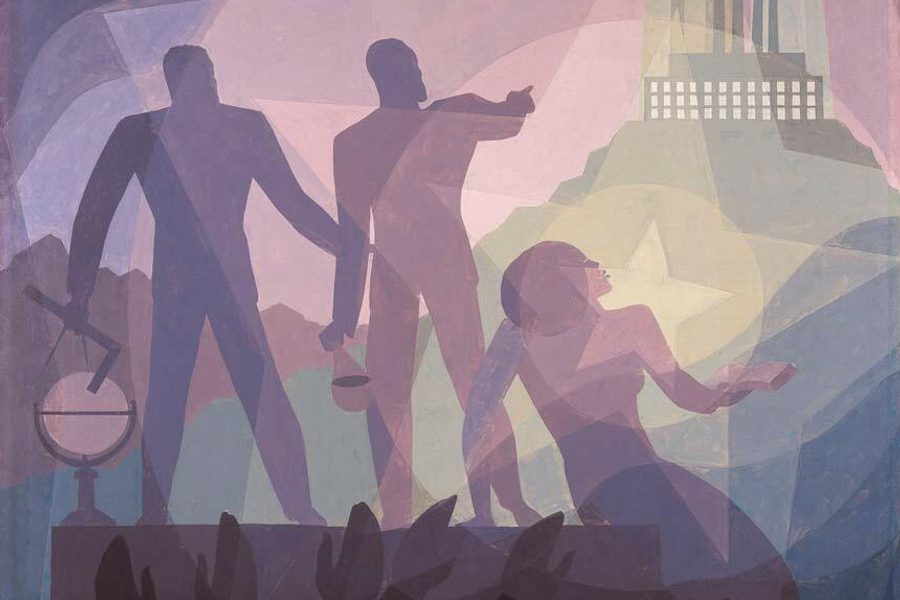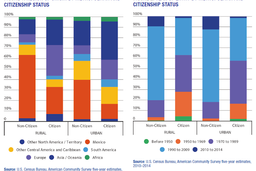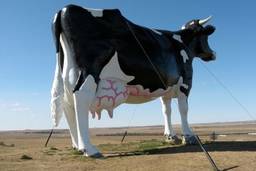The Lively Politics of 1930s Art
The exhibit After the Fall reveals the radicalism—and other political views—behind much of the decade’s painting.
Alex McLeese

During the Cold War, much of the political art of the 1930s was overlooked, overshadowed by other artistic movements like Abstract Expressionism. Now, however, the period is receiving more attention.
The Art Institute of Chicago is showing America after the Fall: Painting in the 1930s. The exhibition, which includes 53 paintings, is advertised as featuring Edward Hopper, Georgia O’Keeffe and Grant Wood. Audiences will also encounter less well-known artists, some of whom made strong political statements.
While not all of the exhibit’s paintings engage directly with the era’s pressing social issues, much of America after the Fall reminds us of the power of political art. Although some art historians In These Times spoke with wished the exhibit included more background on the period’s radical politics, the show does the public service of inviting the viewer to look at past — and present — political art anew. After the show’s run at the Art Institute, which ends on Sunday, the show will travel to the Musee de l’Orangerie in Paris and to London’s Royal Academy.
According to several art historians interviewed, 1930s art appealed to popular audiences. Case Western Reserve University art history professor Henry Adams says that the Depression was the last period in which high and popular art were thought compatible. “Wood and [Thomas Hart] Benton were making serious artistic statements at the same time as they were addressing the American public,” he says. “By the time of Abstract Expressionism, artists were delighted that the general public didn’t understand what they were doing, and were aiming at an elite audience.” For Adams, it is these populist tendencies that make the decade’s art appealing. “A lot of the art we see in museums is presenting high culture divorced from our daily lives,” he says. Painting in the 1930s, however, “resonate[d] with the lives Americans actually lived.”
Artists of the 1930s often engaged their audiences in the contentious political issues of the day. “American audiences were welcoming to a variety of voices, a variety of conversations about politics, that were clamped down in the 1940s and 1950s,” says University of Virginia professor Carmenita Higginbotham. “In the 1930s, the entire culture is receiving a lot of different information, with a lot of voices out there. People … were having a difficult conversation about what was happening.”
Styles of the ‘30s
The Art Institute exhibit includes abstract, Precisionist, Regionalist, socially engaged realist, Magic Realist and Social Surrealist works. Each form related to the “real” in its own way, and each displayed a distinct capacity for expressing political messages.
The Precisionist and abstract art featured in the exhibit tend to avoid direct social criticism.
The Precisionist Charles Sheeler’s paintings were commissioned by businessmen and by Republican Henry Luce’s Fortune magazine. Precisionists, who drew from other traditions such as Cubism and Futurism, paid special attention to the industrialization and modernization of the United States. Sheeler’s paintings of industrial scenes, such as “American Landscape,” included clean lines and simplified elements. “Sheeler was interested in the heroic quality of American industry,” says Adams, adding that he was less political than the Regionalists.
American University professor Helen Langa observes that people were absent in Sheeler’s work. “You can claim that leaving out the human labor presence is an abandonment of political analysis,” she says, characterizing Sheeler as “pro-technology, which ends up having a capitalist element to it, portraying machines not workers.”
The exhibit’s abstract paintings range from optimistic to apolitical. Ilya Bolotowsky, for example, avoided recognizable forms in his work, “Study for the Hall of Medical Sciences Mural at the 1939 World’s Fair in New York,” which represented economic progress.
The modernist painter Stuart Davis, by contrast, engaged with Marxism. But much of his art, including the work featured in the exhibit—“New York-Paris No. 3”—is not explicitly political. However, according to Boston University professor emerita Patricia Hills, Davis saw his work as political because he depicted everyday life, and sought to engage, educate and activate his viewers.
Davis combined abstraction and realism, championed European modernism and sharply criticized American Regionalism, a movement characterized by engagement with regional identities. According to University College London professor emeritus Andrew Hemingway, Davis maintained that modernist practices were inherently radical. But he rejected works that were entirely abstract. As the Whitney Museum of American Art notes in an exhibit text, “even as Davis embraced the idea of art as autonomous, he remained conflicted about pure abstraction, which he felt disregarded art’s social role.”
The Regionalist art on display, like some of the abstract and Precisionist paintings, avoids radicalism. Regionalists Thomas Hart Benton, John Steuart Curry and Grant Wood promoted traditional agrarian values in paintings of rural America. Their work provoked great controversy. “The disputes between Regionalism and the Left were very fierce, especially with Benton, a self-aggrandizing person who was the Donald Trump of 1930s painting,” says Hemingway. “The ruralism of the Regionalists was hokey. They were roundly attacked by the Left and also by many liberal critics.” Regionalism was publicized by Republican Luce’s Time magazine, and was criticized for being conservative, parochial and provincial by left-wing critics such as Davis.
“To see Regionalism as any form of realism would be a mistake,” says Washington University in St. Louis professor Angela Miller. “It featured idealized fantasies about rural life, and was precisely intended in many instances to dispel anxieties about the Dust Bowl. There’s no relation between Thomas Hart Benton and what was really going on.” Works such as Wood’s “Fall Plowing” and “Young Corn,” and Benton’s “Cradling Wheat” and “Haystack,” portrayed idealized landscapes, without modern conditions of erosion, poverty and tractors.
During the 1930s, critics accused Regionalism of promoting nationalism. But Regionalism, other historians say, defied easy categorization. Wood’s attitude towards traditions was complicated. “[Wood]’s technically sophisticated and playful in a way Benton isn’t,” says Hemingway, “with a more original style.” Wood engaged critically with American traditions in multiple paintings. “Daughters of Revolution” satirized the class pretensions of upper-class women. “Parson Weems’ Fable” self-consciously acknowledged the role of mythmakers in shaping a story about George Washington.

“Daughters of Revolution” by Grant Wood (http://www.cavetocanvas.com/post/6257100791/daughters-of-revolution-grant-wood-1932-from)
Another historian suggests that Benton, too, displayed a complicated politics. “People talk about Benton representing an idealized view of American life,” says Adams, who wrote a book on the artist. “In a Missouri mural, a fur trader is selling whiskey to an Indian. It ends with a Kansas City boss sitting in a nightclub with trustees of art. It’s obviously not an idealized view of American life, but a self-aware, critical view of American life. It’s startling the degree to which people reversed the actual message of what was going on in his painting.”
Many modernist and Regionalist paintings addressed the idea of the American nation. Paintings by Benton, Charles Demuth, Marsden Hartley, Georgia O’Keeffe and Wood referred to national and regional identities.
Some of these works were especially successful with the public. During the 1930s, Wood’s “American Gothic” was among the Art Institute’s most popular paintings. These works, historians say, fulfilled a psychological purpose. “In art, national identity fills a need for the community,” says Higginbotham, adding that these paintings provided a “rallying cry for a country trying to heal itself from trauma.”
At the time, some feared that the nationalism expressed in these paintings could be dangerous. Higginbotham says works about national identity can sometimes offer a “way to deflect, defeat, and suppress alternative radical voices, who may be requiring intense reexamination of the nation and what it stands for.” This makes such paintings “not only a source of optimism and unification, but also a source of political suppression.”
At the same time as Regionalism was flourishing, some other socially engaged realists were criticizing the capitalist order. Philip Evergood depicted the terrible conditions facing the poor in “Dance Marathon.” Ben Shahn protested the verdict of a controversial legal case against two anarchists in “The Passion of Sacco and Vanzetti.” Joe Jones portrayed the oppression of black workers in “Roustabouts.” Alice Neel painted the powerful figure of a labor organizer in “Pat Whalen.” Later, during the early Cold War, many of these radical realists were accused of Communist Party activities, sometimes accurately. According to Langa, these radicals painted realistic works because realism — as opposed to certain modernist tendencies — “made their themes more understandable to working-class viewers.”
Miller says Evergood’s work is important because of the way it distorts the “real.” “What is called social realism is not a form of realism, but is an expressive statement about the ways in which capitalism distorts the natural,” she says. “Painters used formal devices to bring home how distorting the forces of capitalism are, to what extent you cannot capture the world around you in naturalistic language, cannot express the realities of a world in crisis, facing fascism. Expressive distortion was one of the most important contributions of the radical art of the 1930s.”
Artists pushed the boundaries of the real in other ways. Social Surrealists and Magic Realists explored these new styles as they were being introduced to America, employing them to warn against fascism. In his controversial “The Eternal City,” Magic Realist Peter Blume caricatured Mussolini’s head as green and grotesque. Eventually, the Museum of Modern Art bought Blume’s painting for the permanent collection. The “Proletarian Surrealist” O. Louis Guglielmi, in his painting “Mental Geography,” portrayed the Brooklyn Bridge under fascist attack.
Historians argue that Surrealism, which influenced these painters, was able to explore the dark psychology of the period’s politics. Surrealism combined particular details with fantastic exaggeration. For painters in the mid-1930s, Adams says, it was “a particularly effective tool for suggesting something ominous was going to happen, including fascism.”
Higginbotham agrees. “Surrealism seems to be a great form to convey a radical political agenda, and is also highly emotional,” she says. “It can respond to visually articulate the irrational, whether violence or political situations that operated on heightened emotions and fear.”
More to Explore
Many of the art historians In These Times interviewed say, after looking at the catalog or seeing the exhibit, that the show is a success. For example, Hills, who curated an exhibit on 1930s realism in 1983, praises the emphasis on Midwestern art. University of California, Irvine professor Cécile Whiting says that the show succeeds in its goal of showing a variety of aesthetic expressions in the 1930s, some of which included political and social commentary. She particularly appreciates the juxtaposition of contrasting rural scenes.
Several caution, however, that an exhibit including only paintings cannot give a comprehensive account of 1930s art and politics. “There were a lot of radical artistic media other than painting, including print media from Works Progress Administration print studios, and lots of various newspapers, with artists as journalists,” says Notre Dame professor Erika Doss.
Langa, who wrote a book on 1930s prints, agrees. “Excluding prints drops out a lot of possibilities on the radical side. It was easier for artists to make prints, and sell in multiples,” she says.
Hills believes the Art Institute’s choices about media carry political consequences. She calls the show a “masterpieces exhibition,” featuring polished paintings. “You separate quality from riff-raff, but it all turns out to be ideological,” she says. “You have Alice Neel and Stuart Davis in there, who are very political, but you really have a small selection of artists who are more political, who tended to do pictures of working-class solidarity.”
America after the Fall is organized by topic. The rooms feature industry and labor, then rural scenes, then comments on American identities, then dystopias, and finally urban scenes. The show includes introductory text paragraphs in each room, as well as labels for most paintings, but is not a full history lesson in itself. Doss notes some of the political conflict is missing, including the conflict between Regionalism and left-wing critics. “I’m not sure American audiences are going to understand how heated conversations really were in the 1930s,” she says. “Some galleries refused to show political work, only Regionalism, or only Stuart Davis. … People did not have a communal conversation about all art as tolerable.”
Miller calls the show “conservative,” observing that the exhibit avoids the Works Progress Administration. “It reaffirms many of our most cherished sentimental notions about the 1930s as a time of community, a time when we were reaching into our collective past for anchoring during a period of radical change,” she says. “It doesn’t skirt the dark side of the 1930s by any means, but the overwhelming framework of the show is one of affirmation, of the 1930s as a time when America found itself.”
Historians point to the omission of several artists, including radical William Gropper. Doss says she appreciates the inclusion of Aaron Douglas (see image at top), and would have added more African-American painters.
Some might argue that the artistic movements of the 1930s contained dangerous nationalist or radical propaganda. But in today’s chaotic and fragmented culture, the more political artistic statements on display, the better. Creating a space for robust dialogue, including on national identity, is the duty of our museums. This exhibit should inspire more shows to feature political art from other periods — including today.






